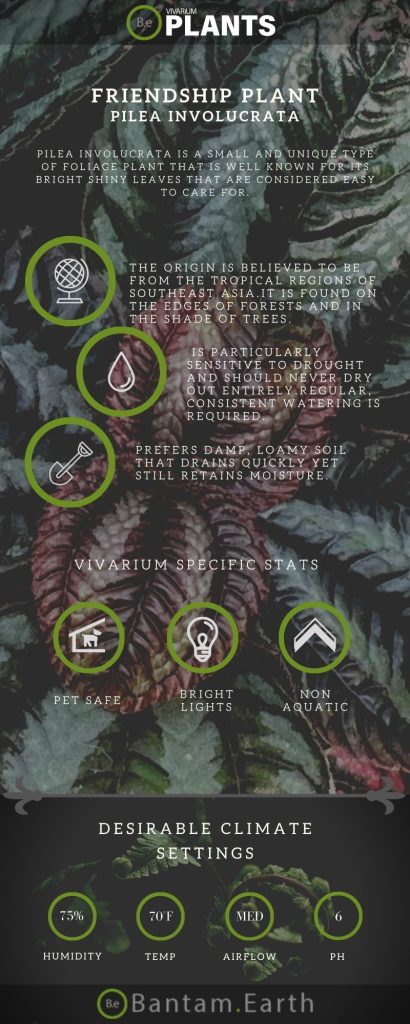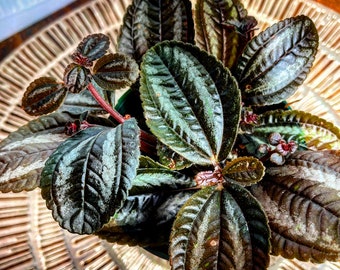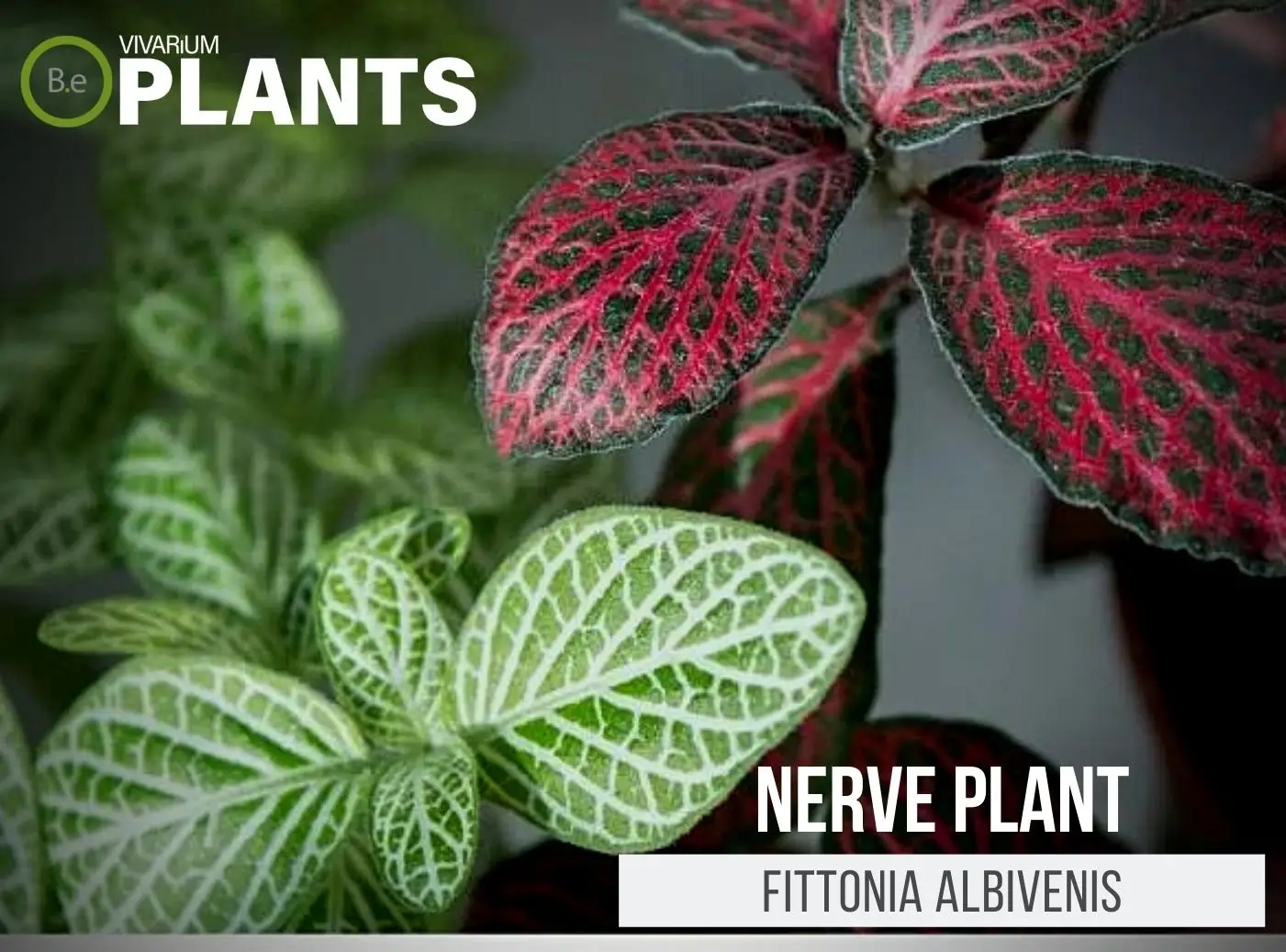The friendship plant is a small and unique type of tropical plant that is commonly used in terrariums and other types of highly humid vivarium projects.
The origin is believed to be from the tropical regions of Southeast Asia.
This plant is well known for its bright shiny leaves that are considered easy to care for.
Despite the easy care, the friendship plant still prefers the humidity of a terrarium and appreciates the dedicated attention of its keeper.
| Quick Stats: | |
|---|---|
| Scientific Name | Pilea involucrata |
| Common Name | Pilea, Friendship Plant |
| Family Name | Urticaceae |
| Habitat | Southeast Asia (Tropical Climates) |
| Temperature | 65°F to 75°F |
| Height | 8 to 12 inches |
| pH | 5.0 to 7.0 |
| Lighting | Bright, Indirect |
Table Of Contents:
ToggleWhat is a Friendship Plant?
Pilea involucrata is a small and fast-growing shrub that is commonly referred to as the friendship plant.
Though the origin of this plant is believed to have originated from tropical regions of Southeast Asia like Indonesia and the Philippines.
It was then brought to the States as an indoor houseplant as well as a vivarium plant.
It is known for its dark green, heart-shaped leaves and will produce small white flowers in an inflorescence.


Friendship Plant Facts
Friendship plant is relatively low maintenance, especially considering the medium it is most commonly found in.
Pilea involucrata does not generally require repotting. Small divisions from the parent plant can be carefully removed and replanted in a moist, well-draining substrate.
The friendship plant produces small runners that can be used to aid in propagation.
Description
Friendship plant stands out in any enclosure due to their unique and stunning foliage.
The leaves of this plant are dark green and can almost appear luminescent when the right amount of light is present.
The leaves are heart-shaped and can reach up to five inches in length.
The underside of these leaves may appear either darker or lighter, which adds an extra eye-catching look to the surface of the plant.
Habitat
Pilea involucrata is a tropical plant and is most comfortable in high humidity and warm climates.
In its natural habitat, the friendship plant is found on the edges of forests and in the shade of trees.
This plant usually reaches its maximum of 12 inches in height, making it an ideal plant for individuals with limited growing space.
PH Preference
Pilea involucrata prefers soil with a slightly acidic pH of between 5.0 and 7.0.
This type of soil is usually fairly moist and usually contains leaf mold and/or peat moss for drainage.
To mimic the natural conditions of its original habitat, individuals should aim for well-drained and not overly wet neutral soil.
Vivarium Type
The friendship plant is quite an easy-going species.
With that in mind, it will not be too complicated when it comes to choosing the type of enclosure it is grown in.
It is best to try and replicate the plant’s natural habitat as much as possible.
Doing so will make it easier to provide this foliage plant with its basic needs.
The proper setup and theme of the enclosure will make a big difference to the overall look and health of the plant.
Be sure to choose setups that are moist and high in humidity. Here are recommended vivariums it will do well in:
- Paludariums – Half aquatic/ half terrain-based enclosure.
- Terrariums – Fully terrain-based enclosures with little to no aquatic features.
Vivarium Placement
As long as the soil is moist but not overly wet, this plant can be placed almost anywhere within a vivarium.
Since it only grows to a maximum of 12 inches, Pilea involucrata serves as a perfect mid-ground foliage option while still being able to fit among most other types of foliage or hardscape.
Substrate
The friendship plant prefers damp, loamy terrarium soil that drains quickly yet still retains moisture.
A substrate made of vermicompost, coconut fiber, and perlite is a great place to start when creating the ideal environment for Pilea involucrata.
This plant also does well in terrariums that are kept moist from the condensation that will build within the wall of the container.
Lighting
Since Pilea involucrata originates from tropical regions, bright and somewhat indirect lighting is best for this plant.
Aim for cooler color temperatures from your lighting source, as excessively hot temps will cause the leaves to scorch and dry out.
In most cases, placing the friendship plant near indirect and diffused terrarium light sources should provide for its proper growth.
Buy Friendship Plants
When it comes to buying a friendship plant, there are a few things to keep in mind.
Making sure the plant is healthy when purchased is essential for its success in a vivarium.
Vegetation that is already in poor conditions will have a very hard time adjusting to new environments.
Click the image below to find out more about the current price and other relative info about this plant.
Friendship Plant Care and Propagation
Since this plant does not require repotting, its care is relatively low maintenance.
This plant is an efficient self-propagator, meaning the plant will produce small offshoots or runners that can be carefully divided and replanted in the substrate of a terrarium in order to create an even more lush look.
How to Grow
The friendship plant responds well to warm temperatures, moisture, and bright indirect light.
When propagating, it is important to make sure the soil is evenly moist and not completely soaked.
The friendship plant grows quickly and is able to spread diffusely within a terrarium due to its ability to produce offshoots.
Watering
The friendship plant requires regular, consistent watering. The soil should be kept evenly moist at all times, especially during its active growing period.
This plant is particularly sensitive to drought and should never dry out entirely.
Be aware that allowing the soil to become too wet will increase the risk of root rot.
Plants Similar to Friendship Plants
Adding diversity to an enclosure is key to an aesthetically pleasing setup.
Try mixing up the look of your vivarium with different flora that can easily co-exist in the same types of environment.
Furthermore, if for some reason you find the friendship plant hard to acquire or would like to consider something similar to this plant…
Here are other tropical plants you might see will do well with or in place of Pilea involucrata:
Conclusion
The friendship plant is an attractive and easy-to-care-for tropical plant that is perfect for humid terrariums and many other types of bioactive vivariums.
It is a strong and hardy plant that thrives in humid conditions and humid air. With patience and proper care, this plant can add a unique and eye-catching look to any enclosure.
Frequently Asked Questions
The Friendship Plant should be watered when the soil feels dry to the touch. During the growing season, water thoroughly once a week. In the winter months, reduce watering to once every two weeks.
A Friendship Plant is best suited to areas of the home that receive bright, indirect sunlight. A window that faces east or west is ideal. Other than direct sunlight, this plant enjoys humidity and moist soil.
In a terrarium, it should be placed in a spot with bright, indirect light and enough space for it to grow. It should be positioned so that its leaves are not touching the glass. The soil should be well–draining and the terrarium should be kept at a temperature of around 65 to 75 degrees Fahrenheit. Additionally, the terrarium should have good ventilation and the Friendship Plant should be watered as soon as the top layer of soil dries.
Friendship Plants (Pilea involucrata) require relatively little maintenance to thrive. For optimal growth, give the plant bright, indirect light and keep the soil moist. Allow the topsoil to almost dry between waterings, and mist the leaves occasionally to maintain humidity. Keep the plant in temperatures above 60°F (16°C). Prune off yellow or brown leaves as necessary. To give it an extra kick, fertilize every two months with a balanced, water-soluble fertilizer for houseplants during the growing season.
No, the Friendship Plant is not toxic. It is generally safe for pets and humans to handle and be around.
Friendship Plant (Pilea involucrata) generally grows to be between 8 and 12 inches tall and 12 and 18 inches wide.




